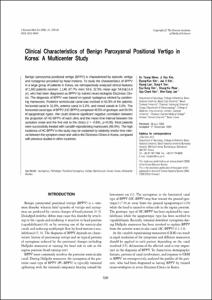Clinical Characteristics of Benign Paroxysmal Positional Vertigo in Korea: A Multicenter Study
- Keimyung Author(s)
- Lee, Hyung; Sohn, Sung Il
- Department
- Dept. of Neurology (신경과학)
- Journal Title
- Journal of Korean Medical Science
- Issued Date
- 2006
- Volume
- 21
- Issue
- 3
- Keyword
- Nystagmus; Pathologic; Positional Nystagmus; Vertigo; Semicircular Canals; Korea; Multicenter Studies
- Abstract
- Benign paroxysmal positional vertigo (BPPV) is characterized by episodic vertigo
and nystagmus provoked by head motions. To study the characteristics of BPPV
in a large group of patients in Korea, we retrospectively analyzed clinical features
of 1,692 patients (women: 1,146, 67.7%; men: 54.6, 32.3%; mean age: 54.8±14.0
yr), who had been diagnosed as BPPV by trained neuro-otologists Dizziness Clinics.
The diagnosis of BPPV was based on typical nystagmus elicited by positioning
maneuvers. Posterior semicircular canal was involved in 60.9% of the patients,
horizontal canal in 31.9%, anterior canal in 2.2%, and mixed canals in 5.0%. The
horizontal canal type of BPPV (HC-BPPV) comprised 49.5% of geotropic and 50.5%
of apogeotropic types. We could observe significant negative correlation between
the proportion of HC-BPPV of each clinic and the mean time interval between the
symptom onset and the first visit to the clinics (r = -0.841, p<0.05). Most patients
were successfully treated with canalith repositioning maneuvers (86.9%). The high
incidence of HC-BPPV in this study may be explained by relatively shorter time interval
between the symptom onset and visit to the Dizziness Clinics in Korea, compared
with previous studies in other countries.
- Publisher
- School of Medicine
- Citation
- So Young Moon et al. (2006). Clinical Characteristics of Benign Paroxysmal Positional Vertigo in Korea: A Multicenter Study. Journal of Korean Medical Science, 21(3), 539–543. doi: 10.3346/jkms.2006.21.3.539
- Type
- Article
- ISSN
- 1011-8934
- Appears in Collections:
- 1. School of Medicine (의과대학) > Dept. of Neurology (신경과학)
- 파일 목록
-
-
Download
 oak-aaa-2922.pdf
기타 데이터 / 81.46 kB / Adobe PDF
oak-aaa-2922.pdf
기타 데이터 / 81.46 kB / Adobe PDF
-
Items in Repository are protected by copyright, with all rights reserved, unless otherwise indicated.